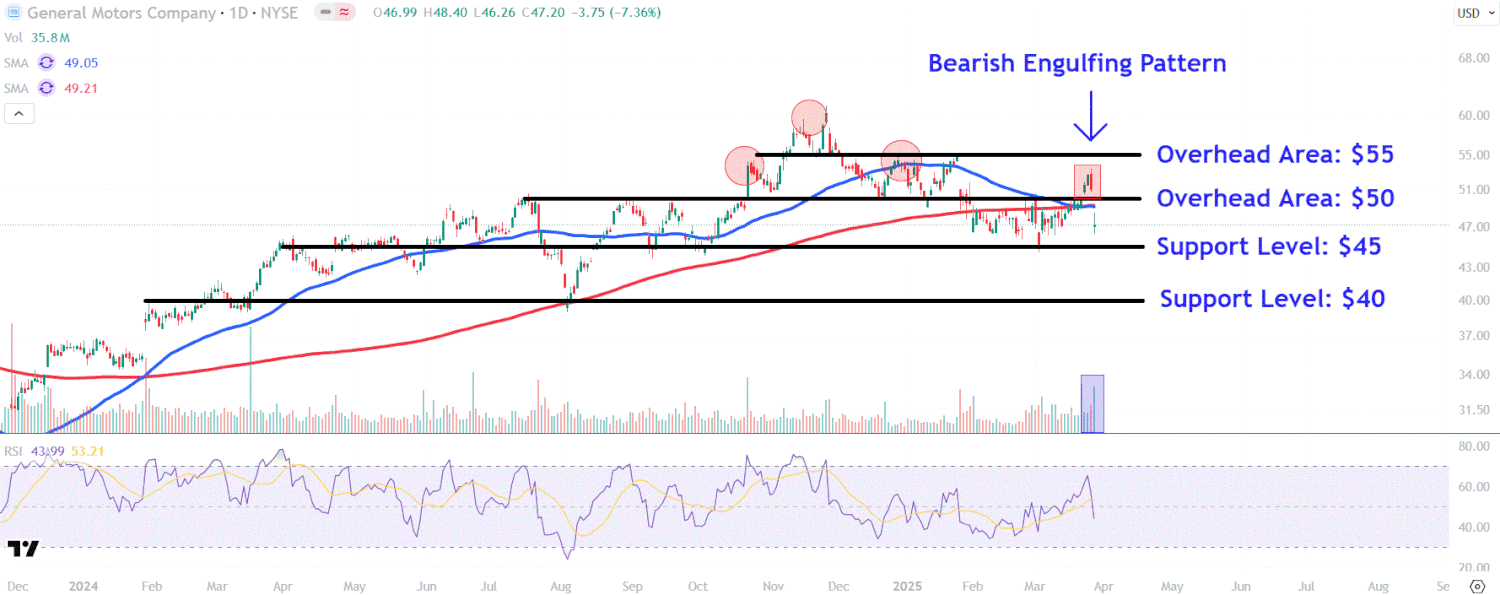Price swings are the new normal – United States

- Weak economic data and trade-related uncertainty negatively impacted sentiment, with equities holding modest gains as yields rose. The dollar remains on track for its worst month in over a year but has been able to rise this week.
- Investor fears of stagflation and recession have replaced initial optimism about Trump’s tariffs boosting growth, reflecting skepticism toward the administration’s economic strategy.
- The Conference Board’s Consumer Confidence Index fell to 92.9 in March, the lowest in four years, with the expectations component plunging to a 12-year low. Households are worried about rising prices and weaker economic conditions.
- Fed officials are cautious about cutting rates amid rising inflation expectations. Governor Adriana Kugler highlighted concerns over inflation surprises and price pressures, indicating reluctance to ease policy too soon.
- The idea of “secondary tariffs” on nations buying Venezuelan oil add and the upcoming 25% car import levy add unpredictability, raising concerns about broader economic and diplomatic effects.
- Positive economic signals emerged as Germany’s Ifo index rose to 86.7 in March, indicating a potential economic bottoming out.
- Despite concerns around the Spring Statement, the British pound remains resilient, with GBP/USD trading near $1.29 and GBP/EUR at €1.20, recovering recent losses.

Global Macro
Tariff angst as April 2nd approaches
Tariff escalation. Uncertainty around the scope and implementation of US tariffs is keeping markets on edge. Trump hinted on Monday that some of his planned levies may not go into effect on April 2, fueling speculation that the administration could adopt a more flexible approach. However, the president’s latest move to introduce “secondary tariffs” on nations purchasing Venezuelan oil and his plans to introduce a 25% car import tax next week add another layer of unpredictability to US trade policy.
Stagflation fears. Hopes that Trump’s tariffs would boost US growth have been replaced by fears of stagflation and recession, with investors increasingly skeptical of the administration’s economic strategy. Consumer confidence took a significant hit in March, with the Conference Board’s index dropping to 92.9, its lowest level in four years. The expectations component was particularly weak, plunging nearly 10 points to a 12-year low. Households appear to be growing more anxious about rising prices and deteriorating economic conditions.
Bottoming Europe. The eurozone’s latest economic activity indicator showed the fastest expansion in seven months, with the composite PMI inching up to 50.4. While this was slightly below market expectations, the manufacturing sector outperformed, offering a glimpse of optimism for an economy that has struggled with stagnation. Germany led the improvement, as anticipation builds over the economic boost from its newly approved fiscal expansion focused on infrastructure and defense.
Swings. The week in markets has been volatile due to the flux of trade news. Equities swung from loses to gains as yields climbed higher on inflation fears. The US dollar has been able to capitalize on that and rose for a second consecutive week.

Week ahead
A monster week to start April
Key events
- RBA decision. The meeting will be closely monitored, especially if the bank deviates from the previous rate of 4.1%. Any surprise could sway the AUD.
- Inflation. We get preliminary inflation rate data from Italy and Germany. The prior rates stood at 1.6% and 2.3% respectively. The Eurozone will release its Inflation Rate YoY Flash for March, with the previous figure at 2.3%.
- ISM and JOLTS. In the US, both the ISM Manufacturing PMI (previously 50.3) and JOLTs Job Openings data (previously 7.74 million) will offer insight into the health of the manufacturing sector and labor market.
- NFP. The highly anticipated US Non-Farm Payrolls (NFP) report for March is set to be released, with consensus at 128K, down from the previous 151K. Alongside the US Unemployment Rate (previously 4.1%), these data points will be crucial in gauging the strength of the labor market and the Federal Reserve’s policy outlook.
Market Themes to Watch
- Trade Uncertainty: Markets continue to react to news related to US trade policy, particularly the recent tariffs on auto imports.
- Economic Divergence: The contrast between strong US data and mixed global indicators may shape currency movements, particularly for the dollar, euro, and commodity-linked currencies.
- Central Bank Policy: The RBA’s stance and inflation data from the Eurozone will be pivotal, while NFP figures could hint at the Fed’s future moves. Expect volatility, especially around major releases like the US NFP, ISM PMI data, and inflation prints from the Eurozone. Traders should be prepared for rapid sentiment shifts driven by economic data and ongoing geopolitical developments.

FX Views
Lack of direction and conviction
USD Month-end rebound. Markets remain on edge as trade policy takes centre stage once again. The safe haven appeal of the US dollar amidst Trump’s latest round of tariff announcements appears to have just outweighed the fear of further erosion of US economic exceptionalism. Despite soft data coming in weak, hard data from the US remains resilient, creating confusion about the true state of the economy. Although the tariff war is seen as slowing the US economy, and could be expressed by broad dollar weakness, short-term losses could be limited due to the dollar’s legacy as a safe haven asset. Moreover, in the very short term – due to the dollar’s weakest month since Nov 2022 and the significant underperformance of US equities – month-end and quarter-end rebalancing indicates a strong dollar-buying signal. Beyond this though, the Greenback’s outlook remains highly uncertain, dependent on economic data, Fed policy, and geopolitical and trade developments. We do note though that over the last 20 years, April has been the dollar’s worst month of the year, averaging a negative return of -0.5%. But seasonality trends play second fiddle to trade wars as “Liberation Day” beckons.
EUR Short-term pain, long-term gain? EUR/USD continues unwinding its overbought condition from earlier this month, with the pair primed for a second successive weekly loss. The 50-week moving average has offered decent support, and staying afloat the 200-day at $1.0720 is critical to maintain a bullish short-term bias. The euro’s outlook has improved thanks to Germany’s game-changing shift in spending plans, which has already bolstered sentiment across the bloc. However, this optimism is being eroded by escalating trade tensions fueling concerns about the Eurozone’s export-heavy economy. If Trump follows through on his double-digit tariffs on EU imports, then EUR/USD could fall back towards $1.05. However, we can’t rule out a resumption of the rotation from US to European assets if traders view tariffs as more damaging to the US economy. Moreover, Europe’s fiscal boost still supports the medium-term bullish outlook for the euro, which is why the repricing at the back end of the euro’s volatility skew shows sentiment is the least bearish for the euro in over three years.

GBP A spring in its step. Despite the UK government’s fiscal plans facing mounting scrutiny, the pound has held up relatively well this week. Gilts remain vulnerable as concerns over sustainability of the spending plan take centre stage, with the fiscal buffer eroding. But investors aren’t dumping the pound and gilts simultaneously like they were at the start of the year when confidence in UK policy was bleak, and stagflation fears were rising. Instead, sterling is rising with yields for now, helped by the largely softer-than-expected inflation report and stronger retail sales figures this week. Sterling appears to hold an international advantage too when it comes to tariffs. Optimism that the UK will avoid the worst of Trump’s reciprocal tariff plan makes it an attractive hedge against tariff noise. This is also evident via its rare positive (albeit weak) correlation with the VIX fear index. Moreover, speculative traders have recently turned net-bullish on the pound’s outlook again according to CFTC data. GBP/USD is on track for a weekly gain, perched above $1.29 – it’s 5-year average – but $1.30 remains a tough hurdle to the upside. And GBP/EUR is back above €1.20, clawing back its month-to-date losses as tariff headlines are punishing the euro.
CHF Trade risk tailwind. The Swiss franc has had a mixed week, rising against the euro and yen, whilst falling against the USD from a 4-month high. Germany’s fiscal initiatives have supported EUR/CHF’s partial alignment with rate differentials, but this effect now seems increasingly priced in. Moreover, as the 2 April tariff deadline nears, the ECB’s dovish stance could come back into focus amid negative tariff developments. And because the SNB has already lowered rates to 0.25%, its capacity to respond to shocks is limited, suggesting a downward bias for EUR/CHF. Conversely, from a technical view – the pair sits above its long-term moving averages, which are pointing higher, suggesting a bullish bias remains intact. Plus, the franc has become the lowest-yielding major currency, so although increased tariff risks might act as a tailwind, if trade tensions ease and risk appetite improves, the franc’s role as a funding currency could help propel EUR/CHF above 0.96.

CNY Holding pattern. It’s been one of the least volatile weeks of the year for the USD/CNY pair, hovering between 7.25 and 7.26. Sentiment remained subdued amid growing concerns over the effectiveness of China’s stimulus measures in offsetting new US tariffs. President Trump’s auto and reciprocal tariffs will add to the 20% levies already imposed on Chinese goods, heightening trade tensions. Meanwhile, the People’s Bank of China announced plans to issue CNY 450 billion in one-year MLF loans and has signaled potential rate cuts. China’s 10-year yields have dropped sharply, pressuring the yuan lower. Technically, USD/CNY looks supported by its 100-day MA in the short term, but topside capped by its 50-day moving average at 7.27.
JPY Looking past inflation. USD/JPY has climbed almost 1% this week, driven by dovish remarks from BoJ Governor Ueda, who downplayed inflation risks and global uncertainties, signaling no urgency for rate hikes. Higher-than-expected Tokyo CPI briefly pressured the pair, but the dollar regained strength as traders doubted an early BoJ policy shift. The Fed’s steady stance has provided underlying dollar support, keeping USD/JPY’s upward momentum intact. Concerns over auto tariffs and potential pressure from Japanese lawmakers ahead of July elections may further delay BoJ rate hikes. For now, USD/JPY’s path of least resistance remains to the upside, supported by contrasting monetary policy outlooks. However, the safe haven appeal of the yen amidst heightened trade policy uncertainty should keep JPY losses limited.

CAD Waiting for April 2nd. The CAD remains closely tied to the tariff situation, with risks heavily tilted to the downside, especially in the short term. According to the Bank of Canada, while domestic Q4 data showed signs of strength and hinted at recovery, the shadow of tariffs has overshadowed this progress. The BoC has also acknowledged that, were it not for the economic threats posed by tariffs, the central bank would have maintained steady interest rates during its latest meeting. Should these tariffs persist long-term, they could impose a significant supply shock, potentially pushing Canada’s economy toward a recession. The uncertainty surrounding this issue is palpable, with ripple effects already evident in slumping consumer confidence and cooling business spending. The Loonie reached a weekly low of 1.423 following Trump’s comments hinting at a potentially softer stance on tariffs toward Canada. However, by week’s end, fresh auto tariff news pushed the VIX higher, and the Loonie posted its weekly high of 1.435. The 100-day SMA serves as a robust support level at 1.4276. Meanwhile, the 20, 40, and 60-day SMAs form a short-term congestion zone between 1.435 and 1.431. The 20-week SMA indicates a neutral level at 1.431 and highlights a medium-term support zone.
AUD Mounting challenges. The Australian dollar is struggling to hold onto the 0.63 handle amid intensifying global trade jitters, with fresh US tariffs set to take effect next week. These escalating tensions have weighed on risk-sensitive currencies like the Aussie, prompting traders to reassess positions. Focus has also shifted to the Reserve Bank of Australia’s upcoming policy decision, where rates are expected to remain steady at 4.1%, leaving little room for immediate support to the currency. Adding to the mix, Australia’s CPI data showed a surprising drop to 2.4% in February, reinforcing expectations of subdued inflation pressures. Meanwhile, political uncertainty has entered the picture as the Prime Minister announced a May 3 election campaign. With slowing price pressures and geopolitical risks intensifying, the Australian dollar faces challenges in maintaining upward momentum and premium to protect against further downside risks is growing.

MXN Dovish Banxico underscores tariff risk. Banco de México reduced the overnight interbank interest rate by 50 basis points to 9.00%, as expected.
The erosion of carry is likely to weaken the peso as rate cuts unfold. The MXN remains one of the most vulnerable emerging market currencies to a U.S. slowdown and equity market corrections, with both domestic and U.S. risks adding pressure. Tariffs also pose challenges, despite efforts by President Sheinbaum’s administration to ease trade tensions. Market uncertainty is expected to persist.
The peso dropped from 20.10 to 20.36 following Banxico’s dovish press release and hasn’t been able to maintain levels below 20 during the week, with April 2nd around the corner. The Peso traded as low as 19.95 and high of 20.36, hitting the 20-week SMA resistance. 20, 40 and 60-day SMA are crossing below the 100-day SMA, creating a strong resistance at the 20.38 level.

Have a question? [email protected]
*The FX rates published are provided by Convera’s Market Insights team for research purposes only. The rates have a unique source and may not align to any live exchange rates quoted on other sites. They are not an indication of actual buy/sell rates, or a financial offer.



























